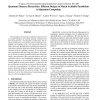Free Online Productivity Tools
i2Speak
i2Symbol
i2OCR
iTex2Img
iWeb2Print
iWeb2Shot
i2Type
iPdf2Split
iPdf2Merge
i2Bopomofo
i2Arabic
i2Style
i2Image
i2PDF
iLatex2Rtf
Sci2ools
ISCA
2006
IEEE
2006
IEEE
Quantum Memory Hierarchies: Efficient Designs to Match Available Parallelism in Quantum Computing
The assumption of maximum parallelism support for the successful realization of scalable quantum computers has led to homogeneous, "sea-of-qubits" architectures. The resulting architectures overcome the primary challenges of reliability and scalability at the cost of physically unacceptable system area. We find that by exploiting the natural serialization at both the application and the physical microarchitecture level of a quantum computer, we can reduce the area requirement while improving performance. In particular we present a scalable quantum architecture design that employs specialization of the system into memory and computational regions, each individually optimized to match hardware support to the available parallelism. Through careful application and system analysis, we find that our new architecture can yield up to a factor of thirteen savings in area due to specialization. In addition, by providing a memory hierarchy design for quantum computers, we can increase ...
| Added | 13 Dec 2010 |
| Updated | 13 Dec 2010 |
| Type | Journal |
| Year | 2006 |
| Where | ISCA |
| Authors | Darshan D. Thaker, Tzvetan S. Metodi, Andrew W. Cross, Isaac L. Chuang, Frederic T. Chong |
Comments (0)

